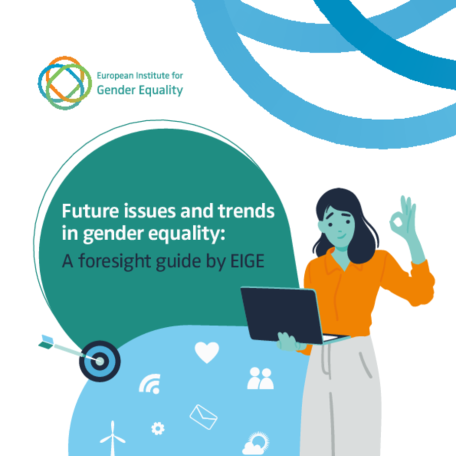Increasing digitalisation has led to a proliferation of so-called "platform work" whereby workers use online platforms (e.g. Uber, Wolt, Bolt) to access clients to deliver specific tasks or services. This note explores some of the characteristics of platform work for those with childcare responsibilities. Furthermore, it investigates gender differences for those carers who live with children in a couple or as lone parents.
EIGE’s survey of platform workers took place between November and December 2020 in 10 Member States (DK, ES, FR, LV, NL, PL, RO, SI, SK, FI). The survey had a sample of around 5000 platform workers. Based on the survey sample, on average 57% of women and 50% of men involved in platform work have childcare responsibilities.
Initial findings show that platform work attracts a higher proportion of workers with childcare responsibilities when compared to the adult working population (in EU countries 47% of working women and 53% of men have caring responsibilities). This suggests that platform work is an attractive alternative for women and men with childcare duties.
According to the survey results, the top motivations to take up platform work for women and men are: i) to earn additional income (45% of women and 40% of men); and ii) to be able to choose when and where to work (43% of women and 35% of men) (see Figures 1 and 2).
The ability to combine platform work with household chores and/or family commitments is also a key motivation, ranking third amongst women overall and for men living with their couple and children. Amongst those households, these factors are cited more often than in households with no children.
As shown in Figure 2, 43% of women and 36% of men with a partner and children report this flexibility as a motivational factor (compared to 31% and 27% respectively in couples without children).
EIGE’s survey shows how women living with children cite balancing paid- and unpaid work as a motivation more often compared to men overall, irrespective of whether they live with a partner or not. For instance, the same proportion of single men with and without children reported being motivated by the ability to combine platform work with house- and/or care work (20%).
In contrast, more women lone parents (31%) are motivated by this flexibility than single women (25%).


Although platform work is usually seen as a flexible alternative for those with childcare responsibilities, it is also usually associated with low pay and unpredictable income. In fact, EIGE’s platform workers survey showed that 33% of women and 29% of men declared unpredictable income as a major drawback, whereas 24% and 22% respectively mentioned unpredictable working hours as a disadvantage.
This was mentioned by both women and men of all household types. Amongst couples with children, slightly more women (38%) than men (33%) selected unpredictable income as a drawback (Figure 3). These proportions were lower and more equal amongst men and women living with their partner and no children (28%).
For women, the third most mentioned common drawback of platform work is low or unfair pay. As shown in Figure 4, both man and women from all types of households declare this as a major drawback. Among lone parents 21% of women and 14% of men mentioned this as a downside. These figures go up to 25% and 21% respectively for those living in a couple with children.


When looking at the income distribution among platform workers, it is clear that women platform workers who are living with children have less income than men, after taking into account all sources of income. More women lone parents are in the lowest income bracket (the first quartile) of reported total income (45%) compared to men (34%) (see Figure 5).

The disparity in income is even higher among couples with children where twice the share of women compared to men fall in the lowest income bracket (30% and 15% respectively).
The higher total income of men platform workers living in couple households with children may be further attributable, at least in part, to men in this situation being slightly more likely to combine platform work with other work: 64% men and 50% of women platform workers with this care responsibility are employed full-time in addition to their platform work (Figure 6).
Among lone parents, however, more women are employed full-time (40%) compared to men (30%), highlighting the particularly vulnerable situation of women lone parents living with children. Among platform workers 45% of women and 34% of men who are lone parents are in the first quartile of the total income distribution.

While there are many factors that impact women and men’s total income, EIGE’s survey shows that women who are regular platform workers (i.e. those who have worked at least occasionally in the last six months), are particularly reliant on their income from platform work.
Just over a quarter (27%) of women have over 50% of their income from platform work, compared to 16% of men. As shown in Figure 7, the highest gender disparity is among those who are in a couple with children: 32% of women participating in the survey who live in a couple with children, earn over three quarters of their income from platform work, compared to 26% of men.

All in all, EIGE’s survey shows that women have slightly different experiences of platform work. Platform work attracts a disproportionate share of women with caring responsibilities who are more often drawn to the flexibility it offers.
According to the survey results, 43% of women mentioned ability to “choose when or where to work” as an advantage of platform work (53% for those cohabiting with children); whereas 36% of them mentioned ability to combine platform work with household chores and/or family commitments as a major motivation (58% for women cohabiting with children).
However, women with childcare responsibilities are more likely to be affected by both the benefits and drawbacks of platform work compared to men. Lone parents of both sexes are vulnerable compared to platform workers at large, possibly because they are less likely to take up full-time employment.
However, women are particularly affected by low overall income. The profile of women in couple households with children is, somehow, different.




